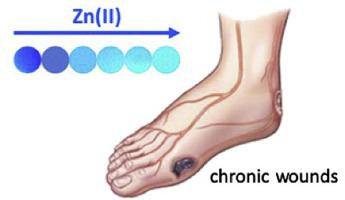Reactive & Functional Polymers ( IF 5.1 ) Pub Date : 2020-07-03 , DOI: 10.1016/j.reactfunctpolym.2020.104685 Marta Guembe-García , Saúl Vallejos , Israel Carreira-Barral , Saturnino Ibeas , Félix C. García , Victoria Santaolalla-García , Natalia Moradillo-Renuncio , José M. García

|
We have developed a new sensory material for the rapid and inexpensive determination of Zn(II), and we have carried out a proof of concept for the determination of Zn(II) in biological samples. The interaction with Zn(II) generates an OFF-ON fluorescence process on the material, which can be recorded both with a fluorimeter and with a smartphone by analyzing the RGB components of the taken photographs. This sensory material is prepared with 99.75% of commercially available monomers and contains 0.25% of a sensory monomer based on a quinoline structure. The sensory motifs are chemically anchored to the polymeric structure, and, accordingly, no migration of organic substances from the material occurs during the sensing process. Our method has been tested with freshly prepared Zn(II) aqueous solutions, but also with biological samples from exudates of chronic wounds. The proposed methodology provides limits of detection (LOD) of 13 and 27 ppb when employing a water-soluble polymer (WsP) and a hydrophilic polymeric film (HP), respectively, using emission spectroscopy. The measurements have been contrasted with ICP-MS as the reference method, obtaining reliable data. This study is the starting point toward a larger investigation with patients, which will address the challenge of establishing a direct relationship between the concentration of zinc(II), other cations and also of amino acids, with the protease activity and, finally, with the state/evolution of chronic wounds. In this context, the proposed sensory material and others we are now working with will act as a simple and cheap method for this purpose.
中文翻译:

使用智能感官聚合物检测生物样品中的Zn(II)
我们已经开发出一种新的感官材料,用于快速,廉价地测定Zn(II),并且我们为测定生物样品中的Zn(II)进行了概念验证。与Zn(II)的相互作用会在材料上产生OFF-ON荧光过程,该过程可以通过荧光计和智能手机通过分析所拍摄照片的RGB分量进行记录。该感官材料由99.75%的市售单体制备,并且包含0.25%的基于喹啉结构的感官单体。感官基序化学固定在聚合物结构上,因此,在感测过程中不会发生有机物质从材料中迁移。我们的方法已经用新鲜制备的Zn(II)水溶液进行了测试,而且还有来自慢性伤口渗出液的生物样本。当分别使用水溶性聚合物(WsP)和亲水聚合物膜(HP)时,通过发射光谱法,所提出的方法可提供13 ppb和27 ppb的检测限。将测量结果与ICP-MS作参考方法进行了对比,从而获得了可靠的数据。这项研究是对患者进行更大范围研究的起点,它将解决在锌(II),其他阳离子以及氨基酸的浓度与蛋白酶活性之间以及与蛋白酶活性之间建立直接关系的挑战。慢性伤口的状态/演变。在这种情况下,拟议的感官材料和我们目前正在使用的其他感官材料将为此目的而作为一种简单而廉价的方法。当分别使用水溶性聚合物(WsP)和亲水聚合物膜(HP)时,通过发射光谱法,所提出的方法可提供13 ppb和27 ppb的检测限。将测量结果与ICP-MS作参考方法进行了对比,获得了可靠的数据。这项研究是对患者进行更大范围研究的起点,它将解决在锌(II),其他阳离子以及氨基酸的浓度与蛋白酶活性之间以及与蛋白酶活性之间建立直接关系的挑战。慢性伤口的状态/演变。在这种情况下,拟议的感官材料和我们目前正在使用的其他感官材料将为此目的而作为一种简单而廉价的方法。当分别使用水溶性聚合物(WsP)和亲水聚合物膜(HP)时,通过发射光谱法,所提出的方法可提供13 ppb和27 ppb的检测限。将测量结果与ICP-MS作参考方法进行了对比,获得了可靠的数据。这项研究是对患者进行更大范围研究的起点,它将解决在锌(II),其他阳离子以及氨基酸的浓度与蛋白酶活性之间以及与蛋白酶活性之间建立直接关系的挑战。慢性伤口的状态/演变。在这种情况下,拟议的感官材料和我们目前正在使用的其他感官材料将为此目的而作为一种简单而廉价的方法。


























 京公网安备 11010802027423号
京公网安备 11010802027423号